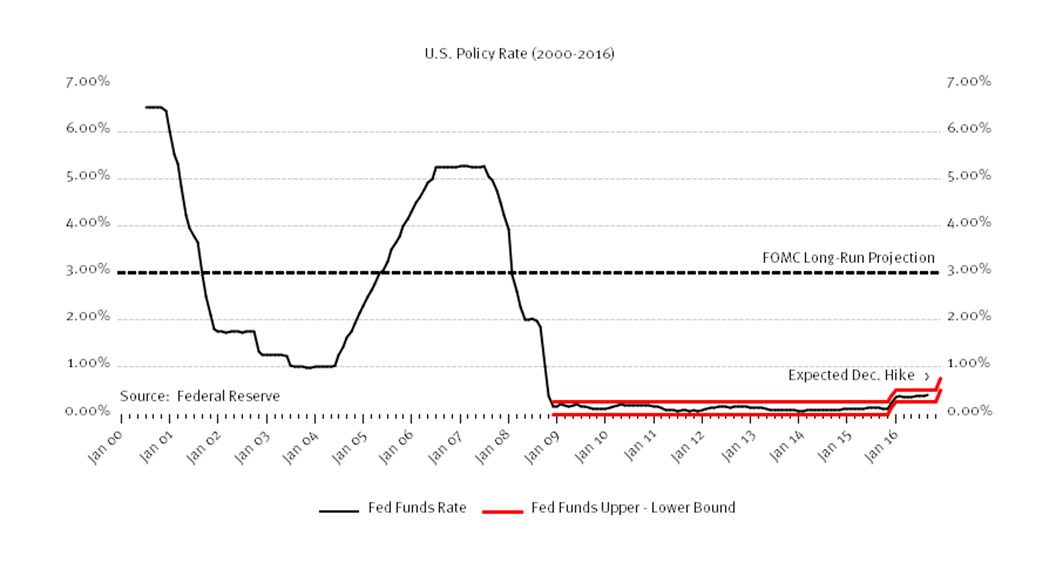Monday Morning Minute 091916
THE WEEK AHEAD
Federal Open Market Committee (FOMC) rate decision, projections, and press conference Wednesday afternoon should garner significant attention and will Likely sets the stage for a December tightening.
MACRO VIEW
This week’s FOMC meeting should set the stage for a December hike. There is little in recent statements that lead us to believe a September tightening is in the cards. Data since July was generally positive, opening the door for a more balanced statement. Brexit failed to produce a worse case dislocation, and leading indicators appear resilient. The WCA Fundamental Conditions Index rose through the summer months, and most forecasters see growth accelerating toward 3% this quarter.
The Federal Reserve (Fed) should acknowledge the improvement in growth. Near-term risks appear to have diminished as we look at various market-based spreads. It follows that “dot-plot” forecasts will likely point toward one more hike this year, followed by gradual 50-basis-point increases in 2017 and 2018. We think the Fed will maintain a long-run target for short rates near 3%, approximately 1% above their long-run inflation target.
Getting back to 3% assumes continued progress. A slip backward would give the central bank ammunition to push off further tightening. There have been stumbles along the way thus far. The European sovereign crisis in 2011 and the China / Emerging Markets-led global growth slowdown of 2014-2015 are examples. Despite a full recovery in asset values and employment, interest rates remain very accommodative (chart below).
We expect this week’s FOMC meeting to:
1) Acknowledge recent improvement in trends;
2) Pave the way for a December rate hike (second this year); and
3) Allow the Fed to reiterate their desire to move deliberately toward tightening, while remaining data dependent.
ECONOMIC RELEASES THIS WEEK
| Date | Report | Period | Survey | Prior |
| Monday, September 19: | NAHB Housing Market Index | September | 60 | 60 |
| Tuesday, September 20: | FOMC Meeting Begins | |||
| Housing Starts M/M | August | -1.5% | 2.1% | |
| Building Permits M/M | August | 2.3% | -0.1% | |
| Wednesday, September 21: | FOMC Rate Decision | |||
| Janet Yellen Press Conference 2:30 PM ET | ||||
| Thursday, September 22: | Weekly Jobless Claims | September 17 | — | 260 K |
| Existing Home Sales M/M | August | 1.1% | -3.2% | |
| Leading Indicators | August | 0.0% | 0.4% | |
| Friday, September 23: | PMI Manufacturing Index Flash | September | 52.0 | 52.0 |
ASSET ALLOCATION PORTFOLIO POSTURE
LONG-RUN STRATEGIC POSTURE: Our long-run forecasts lead us to overweight large cap domestic growth stocks, high-yield corporate bonds, and gold in the diversified “core” of portfolios. Underweight positions in “core” are long-term U.S. Treasuries, foreign developed equities, and REITs. Meanwhile the equity allocation in the short-term tactical “satellite” portion of portfolios was increased to 40% equity / 60% fixed income from 33% equity / 66% fixed income. Mid-year rebalancing took place at the end of June to reflect updated long-run forecasts.
The information contained herein has been prepared from sources believed to be reliable but is not guaranteed by us and is not a complete summary or statement of all available data, nor is it considered an offer to buy or sell any securities referred to herein. Opinions expressed are subject to change without notice and do not take into account the particular investment objectives, financial situation, or needs of individual investors. There is no guarantee that the figures or opinions forecasted in this report will be realized or achieved. Employees of Stifel, Nicolaus & Company, Incorporated or its affiliates may, at times, release written or oral commentary, technical analysis, or trading strategies that differ from the opinions expressed within. Past performance is no guarantee of future results. Indices are unmanaged, and you cannot invest directly in an index.
Asset allocation and diversification do not ensure a profit and may not protect against loss. There are special considerations associated with international investing, including the risk of currency fluctuations and political and economic events. Investing in emerging markets may involve greater risk and volatility than investing in more developed countries. Due to their narrow focus, sector-based investments typically exhibit greater volatility. Small company stocks are typically more volatile and carry additional risks, since smaller companies generally are not as well established as larger companies. Property values can fall due to environmental, economic, or other reasons, and changes in interest rates can negatively impact the performance of real estate companies. When investing in bonds, it is important to note that as interest rates rise, bond prices will fall. High-yield bonds have greater credit risk than higher quality bonds. The risk of loss in trading commodities and futures can be substantial. You should therefore carefully consider whether such trading is suitable for you in light of your financial condition. The high degree of leverage that is often obtainable in commodity trading can work against you as well as for you. The use of leverage can lead to large losses as well as gains.
The WCA Fundamental Conditions Barometer measures the breadth of changes to a wide variety of fundamental data. The barometer measures the proportion of indicators under review that are moving up or down together. A barometer reading above 50 generally indicates a more bullish environment for the economy and equities, and a lower reading implies the opposite. Quantifying changes this way helps us incorporate new facts into our near-term outlook in an objective and unbiased way. More information on the barometer is found in our latest quarterly report, available at www.washingtoncrossingadvisors.com/insights.html.
Client-approved reports and commentaries click here
Kevin Caron, Portfolio Manager
Chad Morganlander, Portfolio Manager
Matthew Battipaglia, Analyst
Suzanne Ashley, Junior Analyst
(973) 549-4052




